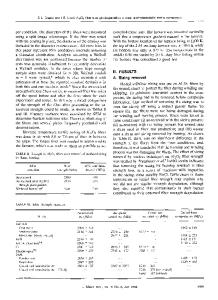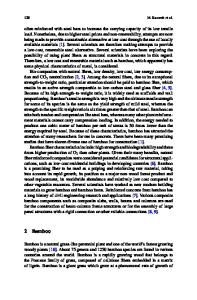Fiber strength utilization in carbon/carbon composites
- PDF / 2,174,856 Bytes
- 11 Pages / 576 x 792 pts Page_size
- 15 Downloads / 388 Views
J. M. Yang Department of Materials Science and Engineering, University of California, Los Angeles, California 90024 (Received 27 November 1991; accepted 26 October 1992)
The utilization of tensile strength of carbon fibers in unidirectional carbon/carbon (C/C) composites was studied for a series of four mesophase-pitch-based carbon fibers in a carbon matrix derived from a polyarylacetylene (PAA) resin. The fibers had moduli of 35, 75, 105, and 130 Mpsi. Composite processing conditions ranged from the cured-resin state to various heat-treatment temperatures (HTT's) from 1100 to 2750 °C for the C/C's. Room-temperature tensile strength and modulus were measured for the various processing conditions, and were correlated with SEM observations of fracture surfaces, fiber and matrix microstructures, and fiber/matrix interphase structures. Fiber tensile strength utilization (FSU) is defined as the ratio of apparent fiber strength in the C/C to the fiber strength in an epoxy-resin-matrix composite. Carbonization heat treatment to 1100 °C results in a brittle carbon matrix that bonds strongly with the three lower modulus fibers, resulting in matrix-dominated failure at FSU values of 24 to 35%. However, the composite with the 130-Mpsi-modulus filament had an FSU of 79%. It is attributed to a combination of tough fracture within the filament itself and a weaker fiber/matrix interface. Both factors lead to crack deflection and blunting rather than to crack propagation. The presence of a weakened interface is inferred from observations of fiber pullout. Much of the FSU of the three lower modulus fibers is recovered by HTT to 2100 or 2400 °C, principally as a result of interface weakening, which works to prevent matrix-dominated fracture. With HTT to 2750 °C, there is a drop in FSU for all the composites; it is apparently the result of a combination of fiber degradation and reduced matrix stress-transfer capability.
I. INTRODUCTION Over the past 20 years, the tensile strengths of both pitch-derived and PAN-derived carbon fibers have increased progressively. However, the strength utilization of such fibers in carbon/carbon (C/C) composites is still disappointingly low, of the order of only 20 to 50% of the mle-of-mixtures prediction1 compared with carbon-fiber-reinforced epoxy composites, which typically utilize 90 to 95% of the fiber strength. Poor utilization of the reinforcement strength in C/C composites, as discussed by Jortner,2 Leong, Zimmer, and Weitz,3 and Fitzer and Hiittner,4 is clearly related to the unique processing that is involved in C/C composite fabrication. Processing-related factors that may contribute to these low strength utilizations are (1) chemical attack of the fiber by matrix pyrolysis gases; (2) matrix cracking, which causes stress concentrations; (3) residual stresses in the fibers (created by thermal expansion mismatches between fiber and matrix during processing); (4) thermal-stress-induced fiber/matrix debonding, resulting in reduced fiber/matrix stress-transfer capability; (5) matrix-initiated fa
Data Loading...











